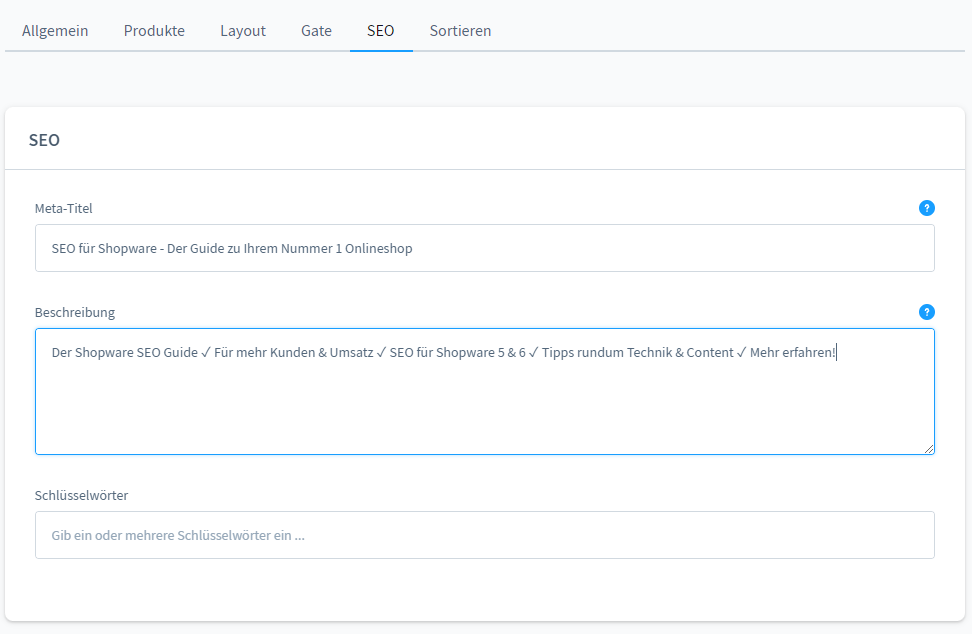If you’ve already put a lot of time into your Shopware store, but sales aren’t coming in or aren’t as high as expected, it’s most likely because potential customers aren’t coming across your online store online.
Despite actively searching for the products you offer, users simply do not come across your store. Therefore, we reveal important tips and tricks to make your online store fit for search and for your customers with Shopware SEO.
Why is SEO so important for Shopware?
With Shopware you can easily and quickly create e-commerce websites with all important functions. The latest versions of Shopware 5 as well as Shopware 6 already offer store owners many options to optimize their online store for search. But that alone is often not enough.
The
Optimizing your own online store for search
is extremely important. Most customers come to your store via search engines, even though they are not looking for you directly. The majority comes across an online store because they are looking for a specific product or product group.
If you offer the products you are looking for and your website is optimized for the search, you will rank higher in the search results. Thus, you attract many new potential customers to your website.
Here is an example:
Their e-commerce website specializes in garden furniture made of various materials.
A potential customer now enters rattan garden furniture.
If their website is SEO optimized, ideally the customer will land on a page that shows them only rattan garden furniture.
This way, the customer doesn’t have to laboriously go through all your products to find what he wants, but gets to see what he really wants right away. This in turn increases the chance that the customer will buy his garden furniture from you and not from the competition.
However, in order for customers to find your pages via search, search engine optimization is required. This includes, on the one hand, the structure of your website, the selection of keywords, the technical requirements and much more.
Keywords that count: The first step for Shopware SEO
Before you start search engine optimization of your Shopware store, there is something that needs to be done before that: The keyword research
If you haven’t already done so, the first thing you should do is to
do a thorough keyword research
. In this way, you identify which terms related to your products are actually searched for by potential customers.
This research will enable you to develop an effective SEO strategy
that ensures your website stands out in search engine results. By using the right keywords, you can ensure that your content is tailored to the exact needs and interests of your target audience.
Shopware SEO settings for URLs, 301 redirects & canonicals – Here’s how!
You can customize URL settings via the SEO Router of your Shopware 5 store. For example, you ensure that Shopware does not create an infinite number of hierarchy levels or you configure your own optimized URLs.
You can find the SEO Router in Shopware 5 as follows:
Settings → Basic settings → storefront → SEO → Router settings
Also in Shopware 6 you can conveniently make changes to the URL settings and customize them to your needs and your store.
In Shopware 6 you can find this under the SEO settings in the SEO URL templates. There you can make all the changes. However, even more information and step-by-step instructions are available in the Shopware documentation.

SEO URLs for articles, categories & more
SEO URLs or also speaking URLs do not contain article numbers or cryptic designations. Instead, they include relevant keywords and descriptive product features.
Here is an example of a non-optimized URL and an optimized URL:
Such URLs are also particularly easy for customers to remember and can thus be reproduced more easily.
You can set all this in Shopware 5 via the SEO Router or in Shopware 6 via the SEO URL templates in the backend. There you can define the URLs of product pages, category pages as well as landing pages.
With the corresponding variables, you can then create completely individual URLs using the article free text fields. Depending on which variables you have selected in the settings, this is how the URL is now created.
For example, you have chosen category and item name (e.g. www. shopwareshop.de/rattan-gartenmöbel/sofa-sofia) or item name and color (e.g. www. shopwareshop.de/sofa-sofia/weiss) for the items. Without specifications, simple standard URLs are generated.
You should carefully consider the structure of your URLs beforehand. Thus, SEO relevant terms should be included that describe the product.
301 redirects for permanent redirects
In Shopware 5, when the item name is changed, a new URL is automatically generated from it. After that, the old URL will be redirected directly to the new one permanently.
With Shopware 6, you can select in the SEO URL templates settings whether a 301 forwarding should take place when a URL is changed or whether the old URL should become a canonical URL.
This means that in both cases there is no duplicate content that could have a negative impact on their rankings in the search results.
In the case of the canonical URL, it is the case that both URLs continue to exist and the user is not redirected directly to the new URL. The canonical tag of a URL is also understood by search engines only as a hint and therefore not always taken over.
This means that the page can still be found via search despite the Canonical tag. So, if you don’t want your customers to see the content again, you should opt for 301 redirection.

The Canonical Tag for Pagination & Duplicate Content
Canonical tags are especially important for pagination and preventing duplicate content. For product listings with many pages, this way each page links to the main page.
If you want to assign Canonical tags to individual pages of your store, a free text field must be set up for this purpose. For paginated pages, Shopware already implements this itself.
On-page Shopware SEO
When optimizing your online store for search, you also need to optimize what can be seen in the foreground. The so-called on-page optimization is an important part of SEO and should therefore not be omitted.
A big area of on-page optimization, which is becoming more and more important, is user experience. This is particularly important for online stores, as a lack of user-friendliness is often reflected in fewer sales.
Who wants to shop where it takes an eternity for the product, shopping cart and payment process to load or where the product images are so small that nothing can be seen?
Therefore, especially the user experience is an important aspect for Shopware SEO. We have therefore compiled some important points for you to pay attention to when optimizing your online store on-page:
The headline structure
The heading structure, which is defined in the HTML code using the tags, is important not only for users, but also for search engine crawlers. Because with the help of the headlines, the crawler can better classify the content. For the optimization of your store, this means that you should always keep to the hierarchy of the headings and that these should stand out visually from the rest of the text by size or color.
In Shopware 6, for example, you have the option to change the color of the headings in the theme settings. To do this, go to Content → Themes and select the theme you are using. Here you now have the possibility to make some adjustments regarding the design.
So if you want to adjust the headings on certain pages, it’s very easy. You select the desired page and switch to the Layout tab. There you will now see all the content listed on the selected page. To customize a heading, now go to the corresponding text field and select the heading. Then select the paragraph character in the menu bar of the text field. Then a drop-down menu will pop up and you can set the desired heading type. Heading 1 corresponds to a
h1 tag, heading 2 a h2 tag and so on.

Loading times & mobile optimization
The functionality of your online store on mobile devices as well as the loading time are also important aspects of search engine optimization. How fast your online store loads depends on many factors, but not all of them you can influence directly. Therefore, you should make sure that you pay attention to the correct dimensioning of used images, for example, and that file sizes are as small as possible.
You should also avoid elements that often have long loading times, such as automated sliders or large videos that play automatically. As far as the mobile-friendliness of your online store is concerned, it is important to choose a responsive theme right from the start that adapts to different screen classes without any problems.
Navigation is an important tool for Shopware SEO. It is extremely important for potential customers to find their way around your store and quickly find the products they are looking for. In addition, the navigation helps the crawlers to better classify and evaluate the structure and content.
In Shopware 6, the navigation comes from the categories you create and the pages below them. Therefore, right from the start you should think carefully about which points in the navigation make sense for your online store and which sub-points should be below them. However, once you have started on it, you still have the possibility to change the points in the navigation.
For example, you can easily change the order of sub-items under a main menu item by simply moving them in the list in the backend. New navigation items or subitems can be created by clicking on the three dots next to a category.
Technical SEO for Shopware
In order to rank well in Google search, it is important that the technical requirements of your store are right. At first, this may sound like you need to be a programmer to do this, but that’s not the case with Shopware.
Here you can optimize some technical aspects yourself without deeper understanding.
Metadata, structured data & rich snippets for more attention in SERPs
In the backend of Shopware 5 & 6, metadata can be customized directly for each page and product. The metadata is an important part of the Shopware SEO. These are your flagship in search and should encourage users to visit your website.
So, you should create interest among potential customers and make them visit your online store. Here we have some tips for optimal metadata:
- Use the keyword or keyword variations in meta title and description
- Highlight the special features of your product
- Use a call-to-action in the meta description (e.g. Buy now!)
- Note the character limit for the title (60 characters) and the description (150 characters)
- Use uniform separators

Even more attention in the search results is provided by so-called rich snippets, which are generated with the help of
structured data
created with the help of structured data. In the search results, for example, users can see the price of a product, its availability, or even which category the item belongs to.

With rich snippets, users get even more information. In addition, the result looks so much more eye-catching and takes up more space in the results list.
Shopware 5 as well as Shopware 6 automatically generate structured data on product, category and manufacturer data. All you have to do is make sure that the data for a product is all complete and up to date. For example, ratings and the number of reviews can be displayed.
Google then reads the data and, in the best case, creates a rich snippet for your product pages.
Sitemaps & robots.txt – For the indexing of your store
With sitemap and robots.txt file you control what is crawled by search engines on your website and what is not. Thus, both are extremely important tools for indexing your e-commerce website.
This is because large websites are also home to many pages that are not particularly relevant for users and search engines. Consequently, the Google bot should not waste its time on it either.
So in the sitemap you can specify all the pages and subpages that should be found by search in any case. With the robots.txt file you give the crawler instructions about which directories should be crawled and which should not. The disallow directive tells the bot not to crawl that particular directory. The Allow directive in turn allows to explicitly crawl this directory.

There, in the best case, you also directly provide the link to your sitemap to help the crawler to capture and index the content of your website. The robots.txt file is always the first port of call for a crawler.
In addition, to help Google better track and index your website, submit your sitemap to Google Search Console as well.
Content SEO for Shopware
Content is extremely important for search engine optimization. SEO texts in particular help to achieve good rankings in search results. The important thing here is that the texts are thematically relevant and adapted to your target group.
Create product descriptions that convince
An essential part of the content for your Shopware online store are the product descriptions of your articles. Often these are simply taken from the manufacturer, but these are usually not optimized for search. Moreover, these are often found on hundreds of others like this in addition to your website.
By writing individual product descriptions for your articles and optimizing them for your target group, you increase dwell time and lower the bounce rate.
Tips for a successful product description:
- Create an individual & detailed description for each item
- Demonstrate your expert knowledge of the product
- Make sure you have a user-friendly layout
- Mention the most important key data (price, composition, size, color selection, delivery time etc.)
- List the advantages of the product
- Answer possible user questions
- Include product videos, if applicable, that show the product in action
- Show customer reviews
- Point out comparable or complementary products in their store
Category texts for more visibility
With both Shopware 5 and Shopware 6, you can customize your product categories. Especially in niche markets or with products that require special explanation, it is worthwhile to insert category texts on such pages.
These provide additional information on the respective product group and offer users added value. In this way, you can succeed in placing the individual product categories of your online store better in the search.
If we stay with our example about garden furniture, it could look like this:
On the category page for the furniture made of rattan add an informative text about this furniture. There you would then, for example, discuss the advantages of rattan, possibly also in contrast to wood or plastic or how durable such furniture is and how it must be maintained.
However, you should make sure that the information actually offers added value to potential customers and helps them to make a decision for or against the product. It is best to try to answer exactly the questions about the products from the category that users might ask before buying.
Images SEO for Shopware
You can also optimize your product images for search. It is important not to give the images generic names with numbers, but meaningful names. Ideally, these also include the corresponding keyword.
In addition, you should add alt tags to the images. These are important if the images on your page ever fail to load. Then the text you entered will be displayed instead.
Alt tags are also important for the accessibility of your page. For people who use screen readers, the alt text then describes what is actually on the image. So describe the image here as accurately as possible and try to include a relevant keyword here as well.
Another tip for your images is to compress them before uploading them to the backend. Files that are too large cause long loading times, especially if the size of the file does not match the actual size displayed on the page.
Therefore, you should also always assign fixed heights and widths to images for display and also upload them exactly in this size.
SEO Tips & Tricks for Shopware
The same principles apply to online stores with Shopware as to any other website. In general, you should pay attention to the following things:
- Fast loading times & correct technical implementation of your online store
- Make sure that your online store is also optimized for mobile devices
- Create unique content that adds value and sets you apart from your competitors
- Expand the internal linking of your website
- Give your products keyword relevant names and do not invent novel terms
You can find even more SEO tips that can be applied to your online store in our
blog post on the topic
.
Shopware SEO with UnitedAds
Our tips are helpful, but they don’t help you with your store yet? Then let us advise you on the topic of Shopware SEO!
UnitedAds is your reliable partner when it comes to search engine optimization. We develop a sophisticated strategy, create SEO texts and take over the implementation. In addition, you have a personal contact person with us who will assist you in optimizing your store.
Über den Autor
Felicitas Bürger arbeitet seit Oktober 2021 bei der UnitedAds GmbH. In ihrer aktuellen Position als SEO Team Lead koordiniert sie das SEO Team und ist für die Entwicklung ganzheitlicher SEO Strategien für Kunden verantwortlich. Seit 2020 befasst sie sich intensiv mit den Themen Suchmaschinenoptimierung und digitalem Marketing.







